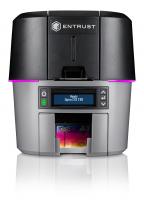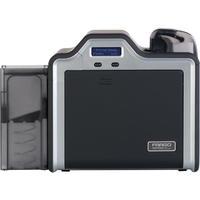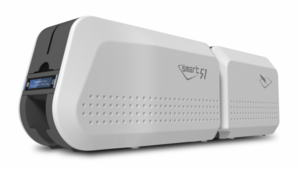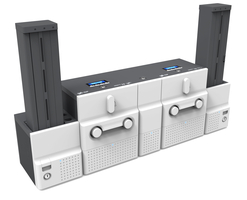ID Card Visual Security
By incorporating visual-security elements into ID cards, card-issuing organizations can—with high confidence—readily verify card authenticity and protect card integrity by minimizing card tampering and illegal duplication. Ensuring the benefits of great visual security depends on printer features, ribbon types, and specialized blank card stock.
Printer Options
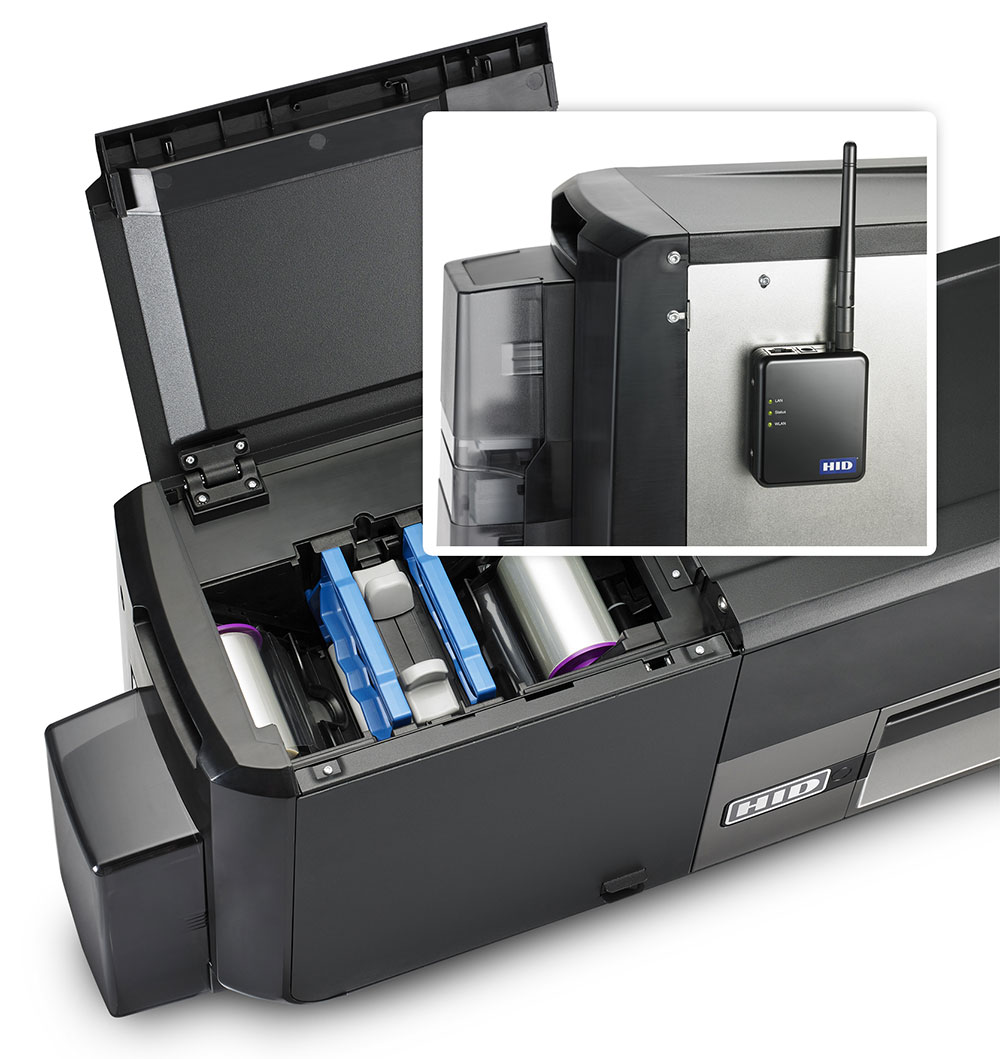
If you've been looking for an ID-card printer you're probably already aware that selecting the right printer with the right features to meet your needs is a daunting task. If you're ID cards must maximize security, the important printer features/functions addressed below need your careful attention.
Laminating Printers
Lamination is a secondary process that adds a clear film to the card using a heated lamination module just after the card design is printed. Laminated ID cards are more durable and tamper resistant, thus offering better protection from counterfeiters. Lamination can be done on one or both sides of an ID card, depending on the printer's configuration options. Lamination capabilities are typically found as an upgrade options on many higher-level ID-card printers.
Printer makers offering over-lamination capability also provide holographic versions of their overlaminate material. Holographic overlaminates appear as "watermarks" on ID cards, and contain hard-to-duplicate designs. Lamination renders the watermark hard to tamper with. They're applied over the card design and allowing the underlying images to remain unobscured. These vary, but commonly employ a holographic image embedded on the overlaminate's surface. Some preconfigured holographic overlaminates also feature microtext printing within the holographic image to enhance fraud protection and security. On higher-level standard and custom holographic overlaminates, custom micro-text printing is an option. Generic hologram designs developed by the overlaminate material manufacturers are most common (these are considered "off-the-shelf"), but if you're looking for highly customized holographic security, custom holographic solutions can be developed, and many ID card printers with overlamination capability allow users to create custom holographic designs for even greater security-and brand enhancement.
Depending on the printer model, users can select a holographic laminate film that best suits their needs from many styles and designs offered by the printer and laminate manufacturers.
- Clear laminates: a clear protective layer of 0.6 or 1.0 mil is applied to your printed cards.
- Standard holographic laminates: choose laminates with holograms for added security as holograms are hard to duplicate.
- Custom holographic laminates: instead of opting for a standard hologram that another company may also use, go for your own custom design. This option guarantees maximum protection to your cards.
Laminates can be patches or overlay. Patch laminates leave an unprotected border around the edge of your cards while overlay laminates cover the entire surface of your cards.
Tactile Impression
This feature uses a heating process to place a stamp on the card's laminate during the printing process-leaving a physical impression on the cards that you can feel. It doesn't require customized consumables, but uses a mechanical die within the card printer's lamination unit that can be stock or customized. This is an advanced security enhancement.
Ultraviolet (UV) Printing
Ultraviolet (UV) or Fluorescent (F) printing-available with select printer models-requires a ribbon with a UV/fluorescent panel on it that can place a customizable image or text on the card. These UV images and text are only visible under a black light, which makes difficult to copy because ID forgers can't copy what they are much less likely to know is there. UV or fluorescent text or images are invisible to the naked eye and optical scanners-and only become visible under special light.
UV/fluorescent overlays allow users to create highly secure and durable ID cards without the added cost of lamination or overlay.
High-Definition Printing
High-definition retransfer (reverse transfer) printers-the most advanced card-printing technology available-print reverse card images onto a flexible, transparent film (retransfer film; a thin clear substrate), and then thermally bond (fuse) the film onto the card surface with heat and pressure as a distinct secondary process. These two-steps-called "reverse thermal image transfer"-don't print directly onto the card surface. Reverse-transfer printers create clearer, crisper cards than traditional dye-sublimation printers; produces rich, vibrant, saturated colors and photographic quality for a better-looking card.
Increased Durability -The bonded transparent film acts as protective coating that keeps the card image(s) from fading over time. The color image is printed onto the underside of the retransfer film (instead of directly on the card), and is then sealed between the card surface and the film's exterior surface. So, the image is protected by that clear film from direct contact with ID card holders, wallets, magnetic stripe, or contact-chip machines. The card keeps its original color and quality much longer than most direct-to-card printers.
Print Consistency - Retransfer printing avoids image-quality issues common with direct-to-card printers that can have trouble printing over the uneven surfaces created by embedded smart chips or antennas and circuits. Retransfer printers print onto a perfectly consistent and controlled substrate (the film) rather than the irregular surface of PVC cards. As a result, nothing disrupts or interferes with print performance.
The increase in clarity/quality offered by retransfer is important if your card design includes microtext and images. Microtext is incredibly small text or design features, invisible to the human eye without a magnifying glass, are hard to see or duplicate, providing an additional layer of protection from fraudulent duplication.
Digital Photos - This may seem obvious, but user photos on ID cards are a major security enhancement and a baseline of security defense. Unfortunately, many enterprises don't bother to include a user photo-maybe for expediency and convenience. Yet a simple-to-take photograph is a fundamental security feature easily added to ID cards.
Any secure ID card design starts with a minimum 300 dpi color photograph. Larger and more vivid images-as design elements-are easier to authenticate. A big value-add in the security department. User photos effectively and quickly confirm a person's identity.
Despite their value as a basic security element that reduces fraud risk, photos aren't foolproof because they can be recreated using optical scanners and copiers.
- Biometric Data - Beyond photos, biometric data can be added to ID cards (e.g., fingerprints and digital signatures), which provide supplemental verification options/challenges. Just like photos, this additional biometric data can be readily stored as images in cardholder files.
Magicard HoloKote®
One ID card printer manufacturer, Magicard, offers ID-card printers that-unlike typical lamination printers-produce holographic overlay images without lamination film or special cards. The Magicard HoloKote process doesn't require special card stock or printer ribbons or the lamination capability (it uses standard blank cards and printer ribbons) which reduces costs.
Magicard printers all offer the HoloKote feature without add-on charges. Magicard printers offer the option to create custom holographic images and to control where designs are placed vis-á-vis other design elements.
Anti-Fraud - Newer Magicard printers offer updated HoloKote and Custom HoloKote options, powered by the all-new LYNK onboard intelligence - for identity with an IQ. The Magicard 600 ID Card Printers lets users print a HoloKote security watermark across the card surface, which can be customized to an organisation's logo, or other unique security design. Users can select from 10 predesigned HoloKote watermark images built into the driver when adding a watermark-style design to cards, and can add as many as 10 unique stored Custom HoloKote designs direct to the printer via Magicard's web tool. This feature takes customized security to a new level. Moreover, when using HoloPatch cards users can highlight an area of the HoloKote watermark to create a high-visibility security seal.
Ribbon Options
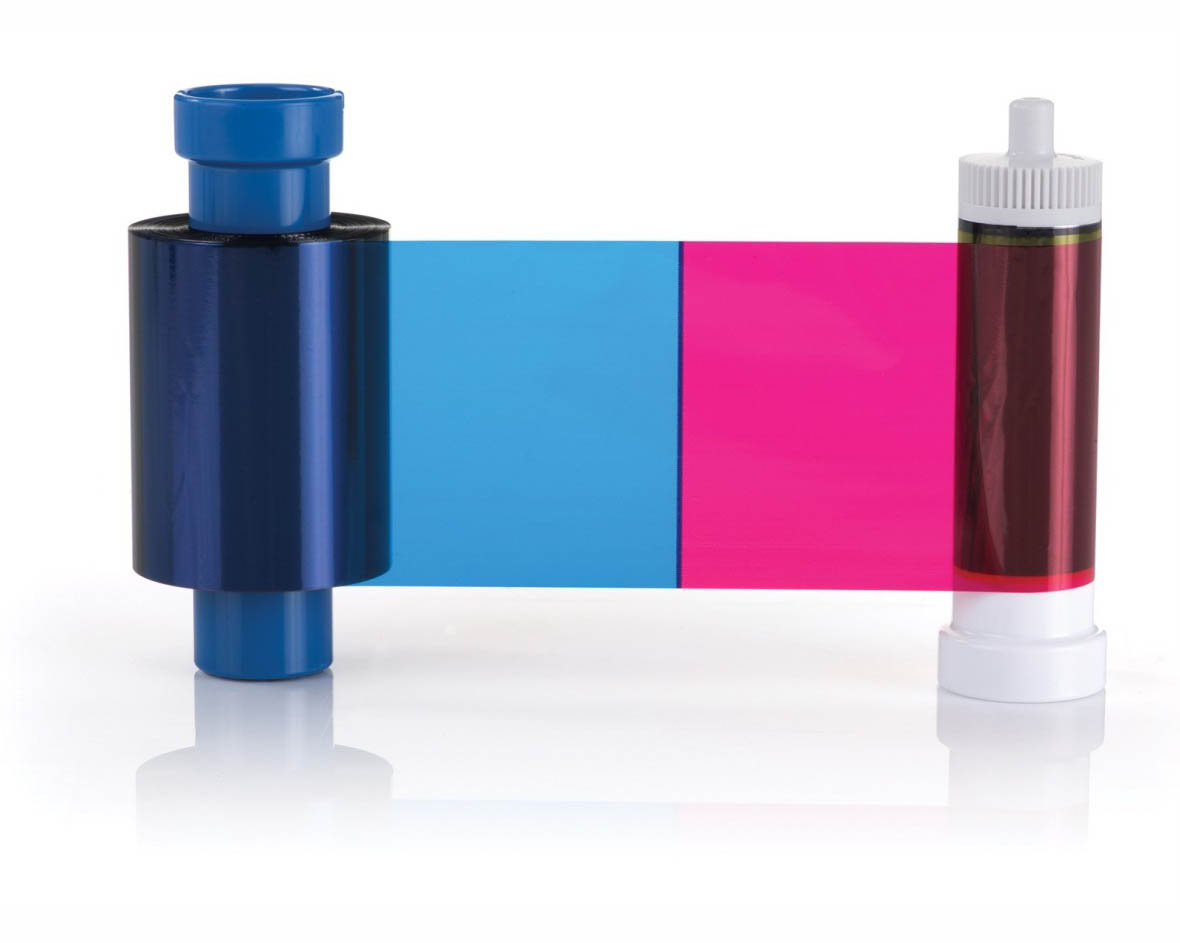
Printer ribbons are a key to high-security ID-card printing-the tool you need to print great card designs and visually secure cards. The ribbon options depend on your design and your ID-card printer. With the right ribbon, you print with high security confidence, from clear cardholder photos to UV printing and holographic lamination.
Security - Ribbon Options
Specialty ribbons beyond standard YMCKO formats can help add security features to ID cards. Ribbon choices featuring specialty colors and special effects, such as tough-to-forge color-shifting graphics and watermarks only visible when tilting the card at an angle or viewing it under UV light. Specialty ribbons permit ultraviolet printing, which is visible under black light only lets you create security features not visible to the human eye. Fluorescent ribbons print fluorescent designs, watermarks, and text allowing easy and quick card authentication.
Review your printer ribbon options:
Not sure what all the ribbon types are? Learn the common ribbon abbreviations.
Security - Lamination Options
Lamination applies an additional clear film protective layer over ID-card surfaces, which increases card security by adding another barrier to fraudulent alteration. For even more security, lamination film that includes holographic images renders your ID cards completely distinctive.
Holographic films undergo the same application process (just like a standard lamination film), but their holographic watermark design appears over the whole ID-card surface. With the watermark, spotting fake, damaged, fraudulent or tampered-with cards much easier to detect.
Each ID printer manufacturer offers its own set of holographic design options. Review your printer's lamination options:
Magicard HoloKote Images
For those with a Magicard printer, your ribbon requirements are simple, since Magicard's unique HoloKote technology lets you add a holographic-like image without special ribbons or films.
HoloKote works with your ID printer's standard ribbons, and adds a secure image across the card's surface using the overlay panel of a YMCKO ribbon.
How to Choose the Right ID Card Printer Ribbon
Idsecurityonline.com offers a seemingly endless range of ribbon supplies-and navigating the choices can be a little confusing. But don't be intimidated; with a few pointers, making the correct ribbon choice for your printer and your printing needs isn't that hard after all.
Choosing the right printer ribbon is well worth a little focus. The options sometimes seem the same, but they're not. Be aware that while more than one ribbon may work with your printer, each ribbon has distinct features and minor differences that can make a big impact on printing outcomes (from flawless printing to technical problems). First, note that the card printer ribbons are printer-brand and printer-model specific. Printers require specifically designed ribbons. The safest bet is to use OEM ribbons.
When comparing and selecting ribbons, let's consider some basics. Ribbons are identified by "letters," in different combinations. The ribbon's color and other features are denoted with letters. Each letter identifies a color or overlay the ribbon can produce. For example, a ribbon identified with all the letters below can print those colors and produce the overlay. YMCKO is an abbreviation used to describe the color panels contained in a PVC printer ribbon. Those labeled "YMCK" can print in color and monochrome, but can't do overlay.
- Y = Yellow
- M = Magenta or Red
- C = Cyan or Blue
- K = Black
- O or T = clear overlay (overcoat and topcoat protective layer that prevents colors from rubbing off)
Some specialty ribbons also have an "I" or "F" panel; "I" stands for "inhibitor panel," which is used to avoid printing on certain areas of the card, and "F" is for fluorescent.
The correct ribbon choice depends on the printer used and what content is printed on each side of the card. To print color on any card side requires the YMCK or YMCKT ribbon.
However, to print color on one side and only black on the other, you'll need an extra "K" (black) panel, making it the YMCK-K ribbon or a YMCKT-KT/YMCKO-KO if you would like an overlay. The second K in the ribbon description means it's designed to print black text on the reverse side as well. These "extra K" ribbons won't work when printing a single- or double-sided color card.
Half-Panel Ribbons - If you don't need full color printing over the entire card surface, "half-panel" ribbons can save money. These ribbons have short panels of YMC-capable of printing an ID photo. The remaining panels are full-size black resin and clear overcoat, allowing text and finishing to be applied over the whole card. Don't use these ribbons if you need color over an entire side of the card!
If you're unsure what you'll need to properly print your ID cards, it's best to call and talk to an ID Professional at ID Security Online. We can ensure you're getting exactly the right ribbons for your card printer-and avoid returns, replacements, and wasted supplies. We're just a phone call away: (888) 618-1230!

Card Options
Blank cardstock for creating ID cards is available in several formats. Standard cardstock is made from plain white PVC. For those intending to add security to their ID cards, composite cards are usually a better choice, especially when using embedded visual features or holographic images to protect cards from tampering.
- 100 % PVC cards - these are the most common type of plastic cards. Designed to work with any card printer, PVC cards are a safe choice for professional ID cards and badges.
- Composite cards - because these are 60% PVC and 40% PET, they're more durable than standard PVC cards. They're also heat resistant and won't bend under high temperatures. Composite cards can be used with any card printer, but are highly recommended for retransfer and laminating printers.
Users can purchase specialty cardstock with built-in security features:
- Embedded holographic designs, images and text, which are available in a range of designs and styles.
- Embedded foil patches.
- Holographic Foil ID Cards - Cards can also be embedded with foil patches with holographic images, which allows image customization, making it unique and hard to duplicate. Holographic foil ID cards effectively enhance visual security but are limited to PVC or composite plastic card stock (they aren't compatible with proximity cards, smart cards, etc.).
Embedding these features into composite cards is accomplished in two ways: embedding a design or foil onto the surface of the card, or embedding it into the card between PVC layers. Both types of embedded security cards allow users to print their design normally and the embedded hologram appears just like a normal watermark.
These card styles are available from manufacturers like Magicard, Zebra, and Fargo, and users don't need an advanced or upgraded printer to print on these cards.
ID cards created using cardstock with embedded visual features are hard to duplicate using standard cardstock, further protecting users from counterfeit cards.





